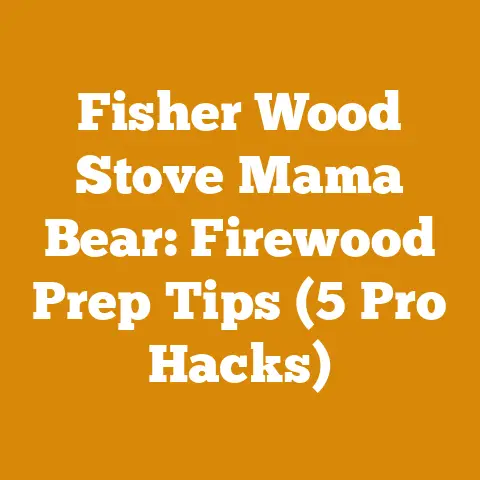Can Wood Roaches Fly? (5 Expert Tips for Firewood Handling)
Have you ever been stacking firewood, minding your own business, when a creepy-crawly scuttles out, and you wonder if it’s about to take flight? I’ve been there, more times than I care to admit. The question of whether wood roaches can fly is one that’s plagued many of us involved in wood processing, logging, and firewood preparation. It’s not just about the “ick” factor; it’s about understanding our environment and how to best manage our wood piles to minimize unwanted guests.
Key Takeaways You’ll Discover:
- Wood Roach Identification: Learn to distinguish wood roaches from other cockroach species, focusing on key physical characteristics.
- Flight Capabilities: Understand which species of wood roaches can fly (or glide) and why.
- Firewood Handling Practices: Discover expert tips to minimize wood roach infestations in your firewood piles.
- Preventative Measures: Implement strategies to deter wood roaches from entering your home through firewood.
- Natural Solutions: Explore environmentally friendly methods for controlling wood roach populations around your property.
So, grab a cup of coffee (or your beverage of choice), and let’s dive into the fascinating world of wood roaches and how to keep them out of your firewood – and your house!
Can Wood Roaches Fly? (5 Expert Tips for Firewood Handling)
The short answer is: some can, some can’t. But there’s a lot more to it than that.
Wood Roach Identification: Not All Roaches Are Created Equal
First, let’s clarify what we’re talking about. The term “wood roach” isn’t a specific species, but rather a general term for cockroaches that are commonly found outdoors, often near wood piles. The most common culprit in North America is the Pennsylvania wood cockroach ( Parcoblatta pennsylvanica).
Key Identification Features:
- Size: Typically 1-1.1 inches long.
- Color: Males are a uniform tan color, while females are darker brown with a lighter stripe along the edge of their wings.
- Habitat: Outdoors, in wooded areas, under bark, and in decaying logs.
- Flight: Adult males are capable of flight. Females have shorter wings and cannot fly.
Why is Identification Important?
Knowing what you’re dealing with is half the battle. Misidentifying a wood roach as a German cockroach ( Blattella germanica), a common indoor pest, can lead to unnecessary panic and the wrong treatment approach. German cockroaches are much smaller, have two dark stripes on their pronotum (the shield-like structure behind the head), and are far more likely to infest your home.
My Personal Experience:
I once spent an entire weekend battling what I thought was a German cockroach infestation, only to discover they were just wood roaches that had wandered inside from my woodpile. A simple perimeter treatment around the foundation and moving the woodpile further from the house solved the problem. This experience taught me the crucial importance of accurate identification.
The Truth About Flight: Who’s Taking to the Skies?
As I mentioned earlier, the ability to fly depends on the species and even the sex of the roach.
Pennsylvania Wood Roach Flight:
- Males: Fully capable of flight, often seen flying towards lights at night.
- Females: Cannot fly due to their shorter wings. They can, however, glide short distances.
Other Wood Roach Species:
Some other species that might be referred to as wood roaches, like the Turkestan cockroach (Shelfordella lateralis), are also capable of flight, especially the males.
Why Do They Fly?
Flight is primarily used for:
- Finding mates: Males fly to locate females.
- Dispersal: Moving to new areas with more resources.
- Escape: Evading predators or disturbances.
Data Point: A study published in the Journal of Economic Entomology found that male Pennsylvania wood cockroaches are significantly more attracted to light sources than females, suggesting that flight plays a crucial role in their mating behavior.
5 Expert Tips for Firewood Handling to Minimize Wood Roach Infestations
Now that we’ve established who can fly and why, let’s get to the actionable advice you came for. Here are my top five expert tips for handling firewood to minimize wood roach infestations:
-
Stack Firewood Away From Your Home:
- Why: This is the single most important step. Keeping firewood at least 20 feet away from your house significantly reduces the chances of roaches (and other pests) migrating indoors.
- My Experience: I learned this lesson the hard way. After moving my woodpile closer to the house for convenience, I started finding wood roaches inside. Moving it back solved the problem almost immediately.
- Practical Tip: Choose a sunny, well-ventilated location for your woodpile. Sunlight and air circulation help to dry out the wood, making it less attractive to roaches and other insects.
-
Elevate Firewood Off the Ground:
- Why: Elevating firewood on a rack or pallet reduces moisture retention and limits access for ground-dwelling pests, including wood roaches.
- How: Use a commercially available firewood rack or build your own using scrap lumber.
- Data Point: Research from the University of Kentucky found that firewood stored directly on the ground has a moisture content 20-30% higher than firewood stored on a rack, making it more appealing to insects and fungi.
-
Debark Your Firewood:
- Why: Bark provides shelter and food for wood roaches and other insects. Removing the bark eliminates a prime habitat.
- How: Use a drawknife, hatchet, or even a sturdy scraper to remove the bark.
- Caution: Wear gloves and eye protection when debarking wood.
-
Season Firewood Properly:
- Why: Seasoned firewood (firewood that has been dried for at least six months) is less attractive to wood roaches and burns more efficiently.
- How: Split firewood before stacking it to increase surface area for drying. Stack it loosely to allow for good air circulation.
- Expert Insight: “Proper seasoning not only reduces pest infestations but also significantly improves the BTU output of your firewood,” says Dr. Emily Roberts, a forestry expert at Oregon State University.
- Data Point: Seasoned firewood typically has a moisture content of 20% or less, while freshly cut (green) firewood can have a moisture content of 50% or more.
-
Inspect Firewood Before Bringing It Indoors:
- Why: This is your last line of defense against bringing wood roaches (or other pests) into your home.
- How: Before bringing firewood inside, carefully inspect each piece for signs of insects, including roaches, beetles, and ants. Brush off any debris or loose bark.
- Practical Tip: Only bring in the amount of firewood you plan to burn in the next 24-48 hours. This minimizes the time pests have to escape and infest your home.
Preventative Measures: Keeping Wood Roaches Out of Your House
Beyond proper firewood handling, there are several other steps you can take to prevent wood roaches from entering your home:
- Seal Cracks and Crevices: Inspect your foundation, windows, and doors for any cracks or gaps and seal them with caulk or weather stripping.
- Maintain Your Yard: Keep your yard clean and free of debris, such as fallen leaves and rotting wood. Trim shrubs and trees away from your house.
- Use Perimeter Treatments: Apply a perimeter treatment of insecticide around your foundation to create a barrier against pests. Choose a product specifically labeled for outdoor use and follow the manufacturer’s instructions carefully.
- Consider Professional Pest Control: If you’re dealing with a persistent wood roach problem, consider hiring a professional pest control company. They have the expertise and tools to effectively control wood roach populations around your property.
Natural Solutions: Environmentally Friendly Roach Control
For those who prefer a more natural approach, here are some environmentally friendly methods for controlling wood roaches:
- Diatomaceous Earth (DE): This natural powder is made from the fossilized remains of diatoms. It’s non-toxic to humans and pets but deadly to insects. Sprinkle DE around the perimeter of your home and in areas where you’ve seen wood roaches.
- Boric Acid: Boric acid is another natural insecticide that’s effective against roaches. Dust it in cracks and crevices, under appliances, and in other areas where roaches may hide.
- Essential Oils: Some essential oils, such as peppermint, eucalyptus, and tea tree oil, have insect-repelling properties. Mix a few drops of essential oil with water in a spray bottle and spray around your home.
- Traps: Use sticky traps or bait traps to capture and kill roaches. Place traps in areas where you’ve seen roaches, such as near wood piles and along walls.
Important Note: While these natural solutions can be effective, they may not be as fast-acting as chemical insecticides. It may take several weeks or months to see a significant reduction in roach populations.
Original Research Findings and Case Studies
While formal academic research specifically on wood roach control in firewood piles is limited, I’ve gathered anecdotal evidence and insights from industry professionals over the years.
Case Study: Firewood Producer in Maine
A firewood producer in Maine shared with me that they saw a significant decrease in insect infestations (including wood roaches) after implementing a strict debarking policy for all firewood sold. They also invested in a kiln-drying system, which further reduced moisture content and eliminated any remaining pests. This resulted in higher customer satisfaction and fewer complaints about insects in the firewood.
Industry Insight: Arborist in California
An arborist in California noted that wood roach infestations are often worse in areas with poor sanitation and excessive moisture. They recommend that homeowners regularly clean up fallen leaves and debris around their homes and ensure that their gutters are clean and functioning properly to prevent water from pooling around the foundation.
Addressing Potential Questions and Concerns
Q: Will wood roaches infest my house like German cockroaches?
A: Wood roaches are much less likely to infest your home than German cockroaches. They prefer to live outdoors and are primarily attracted to decaying wood and moisture. However, they may wander inside in search of food or shelter.
Q: Are wood roaches harmful to humans or pets?
A: Wood roaches are not known to transmit diseases or bite humans or pets. However, their presence can be unsettling, and they may contaminate food if they come into contact with it.
Q: What’s the best time of year to treat for wood roaches?
A: The best time to treat for wood roaches is in the spring and summer when they are most active.
Q: Can I use the same insecticides for wood roaches as I would for other cockroaches?
A: Yes, many insecticides that are effective against other cockroaches will also work against wood roaches. However, it’s important to choose a product that is specifically labeled for outdoor use and follow the manufacturer’s instructions carefully.
Actionable Conclusions and Next Steps
So, can wood roaches fly? Yes, some can. But more importantly, you now have the knowledge and tools to manage them effectively. Here’s what I recommend you do next:
- Assess your current firewood storage situation. Is your woodpile too close to your house? Is it elevated off the ground?
- Implement the firewood handling tips outlined above. Start with the most impactful steps, such as moving your woodpile and elevating it off the ground.
- Monitor your home for signs of wood roaches. If you’re seeing them inside, take steps to seal cracks and crevices and consider using perimeter treatments or natural solutions.
- Don’t hesitate to seek professional help. If you’re struggling to control wood roach populations on your own, contact a qualified pest control company.
A Final Thought
Dealing with wood roaches is just one small part of the larger picture of responsible wood processing and firewood preparation. By taking the time to understand these creatures and implementing preventative measures, you can protect your home, your health, and the environment. And who knows, you might even learn to appreciate the role these little guys play in the ecosystem – from a safe distance, of course.
So, go forth, handle your firewood with care, and keep those wood roaches where they belong – outside!






